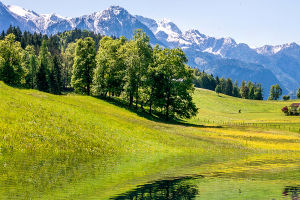A waterfall is a breathtaking natural wonder that is formed by the almost vertical descent of river or stream water through the steep slope or cliff of the riverbed longitudinal section. The formation of a waterfall is a result of the interplay of the earth's internal and external forces.
Waterfalls are formed when a river flows through a cliff-like riverbed, creating a form of water movement. The river provides the material basis for the formation of the waterfall, and the size of the river's water volume determines the size of the waterfall.
The second element is the cliff-type riverbed, which enables the conversion of the potential energy of gravity into the kinetic energy of water flow, and acts as a power source to promote the formation and development of waterfalls.
The sharp drop of terrain intensifies the erosion of the riverbed by external forces, leading to the constant change in the shape and scale of the waterfall.
The reasons for terrain drop are many, including the natural drop of the terrain, the weakness of the lithology of the riverbed, the uplift movement of the tectonic movement, the action of the glacier, and the meteorological and hydrological conditions, among others.
Waterfalls are transient because they are affected by the drop, the amount of water, the type and structure of the rock, and some other factors, leading to their eventual disappearance.
However, new waterfalls are born over long periods due to the geological movement of the earth, which has caused the uplift of mountains and terraces, and the fracture and dislocation of strata, creating conditions for the birth of new waterfalls. Thus, the beautiful and spectacular natural scenery of waterfalls will not disappear from the earth.
Waterfalls are a universal symbol of natural beauty. They are found in different mountain ranges around the world, especially in some high mountain areas. The spectacular sight has a special attraction for people.
The final water source of a waterfall is just a large pool, which is affected by atmospheric pressure and emerges from the ground. The water source of the waterfall becomes more abundant after being blessed with rain and snow.
Human culture and history are also closely related to waterfalls. Many famous waterfalls around the world are important symbols of human culture and belief, such as Niagara Falls, Victoria Falls, Rhine Falls, and others. These waterfalls have been given mythological and legendary significance and have become an important part of the local culture.
Waterfalls have also become important tourist attractions. Many people make special trips to famous waterfalls to watch, take pictures, and play, which promotes local economic development.
However, we also need to pay attention to protecting the ecological environment of the waterfall and preventing over-development and man-made destruction.
Waterfalls are a unique natural landscape on earth that is not only beautiful but also carries rich connotations of nature, culture, and history. We should cherish this natural resource, develop and utilize it appropriately, protect the ecological environment of the waterfall, and allow the beautiful sight of the waterfall to continue.


